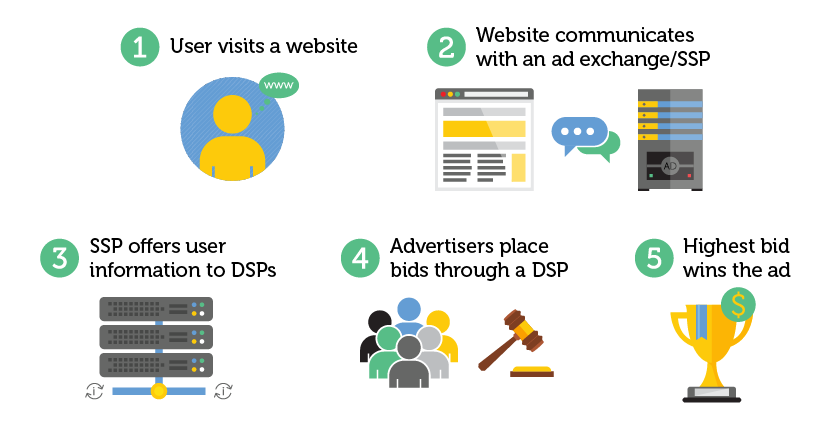As we all know, programmatic advertising can make your head spin. So we wanted to break down the difference between the three main types of programmatic: Real-time bidding, Private Marketplace, and Programmatic Direct.
How does real-time bidding work?
Real-time bidding is a computer-run auction that allows advertisers to compete to serve targeted ads to their desired customers.
The ads are generated based off of the user’s cookies, based on the user’s cookie history. This helps advertisers target the audiences interested in their products.
To make these bidding decisions, advertisers use technology that combines information about the webpage as well as the user. The URL, content category of the page, location of the ad space, and the user’s browser cookies all affect how much an advertiser is willing to pay to serve an ad.
Real-time bidding is typically the most cost-effective form of programmatic advertising. However, it offers the least precision for both publishers and advertisers. Out of all forms of programmatic advertising, RTB is the largest – billions and billions of impressions are served each day. This is where most programmatic buying happens, because there are thousands and thousands of advertisers are competing for RTB inventory.
How do PMPs work?
PMP stands for Private Marketplace. Private Marketplace Deals are invitation-only real-time bidding auctions where one or several publishers invite a select number of advertisers to buy their inventory.
With PMP deals, the advertiser cuts out the middleman and skip over the exchanges and service-side platforms all together. Advertisers also get access to premium sites for cheaper than they would with programmatic direct. The advertisers also know exactly which sites their ads will run on.
PMPs are usually facilitated with an IO, or Insertion Order. This is a contract that spells out how much the buyers are willing to pay for the inventory and how long the ads with run.
The CPM is usually not a fixed CPM, meaning the advertisers don’t pay a CPM agreed upon in advance.
PMPs and Programmatic direct have a few different advantages for pubs and buyers. Publishers are more aware of who is serving ads on their sites, and they can sell the space for more money. But in order to justify paying more, buyers want preferential access to the supply. They basically want to find their target audience before their competitors.
How does programmatic direct work?
Programmatic direct is slightly different to PMP deals. Programmatic Direct is direct-sold, guaranteed inventory, that unlike PMP deals doesn’t require human intervention to run.
However, Programmatic Direct is actually a more manual process than PMP deals.
This is because deals are made on an individual basis, where a publisher’s sales rep negotiates the arrangement with the advertiser on a one-to-one basis.
With Programmatic Direct, the advertiser purchases a fixed CPM, meaning the advertiser agrees to paid a predetermined CPM.
Programmatic Direct is a good choice for brands focused on brand safety, as the relationship is one-to-one and the brands know exactly where their ads will appear. Learn more about programmatic direct buying from this resource.
A metaphor for understanding the difference between RTB, PMPs and programmatic direct
So to summarize, here’s a way to conceptualize the flow from Open RTB to PMP to direct.
The open market (RTB) has thousands of advertisers and millions of sites in it. When buyers are looking for very specific people, that’s difficult. Think of a huge farmer’s market with thousands of farmers and thousands of buyers, and you’re a buyer looking for the perfect apples. You know you’re looking for big, green, organic, and ripe. You can find a good one, but the odds of you actually finding the perfect apple aren’t great.
So now you can pay extra to go into the VIP area where only the best apple farmers are, but the cheapest apple is $5. You can now find the apple you want, but you’re still competing with all the other buyers to find the one you want. At least your odds are better. This is equivalent to PMPs.
But you really want this perfect apple, and you know which farmer has it. He says he will give you the perfect apple for $10, but he will deliver it to your house and skip the farmer’s market and price haggling altogether. This is how programmatic direct works.




